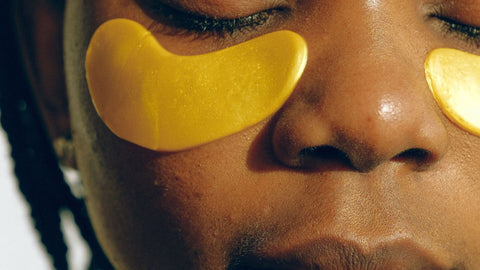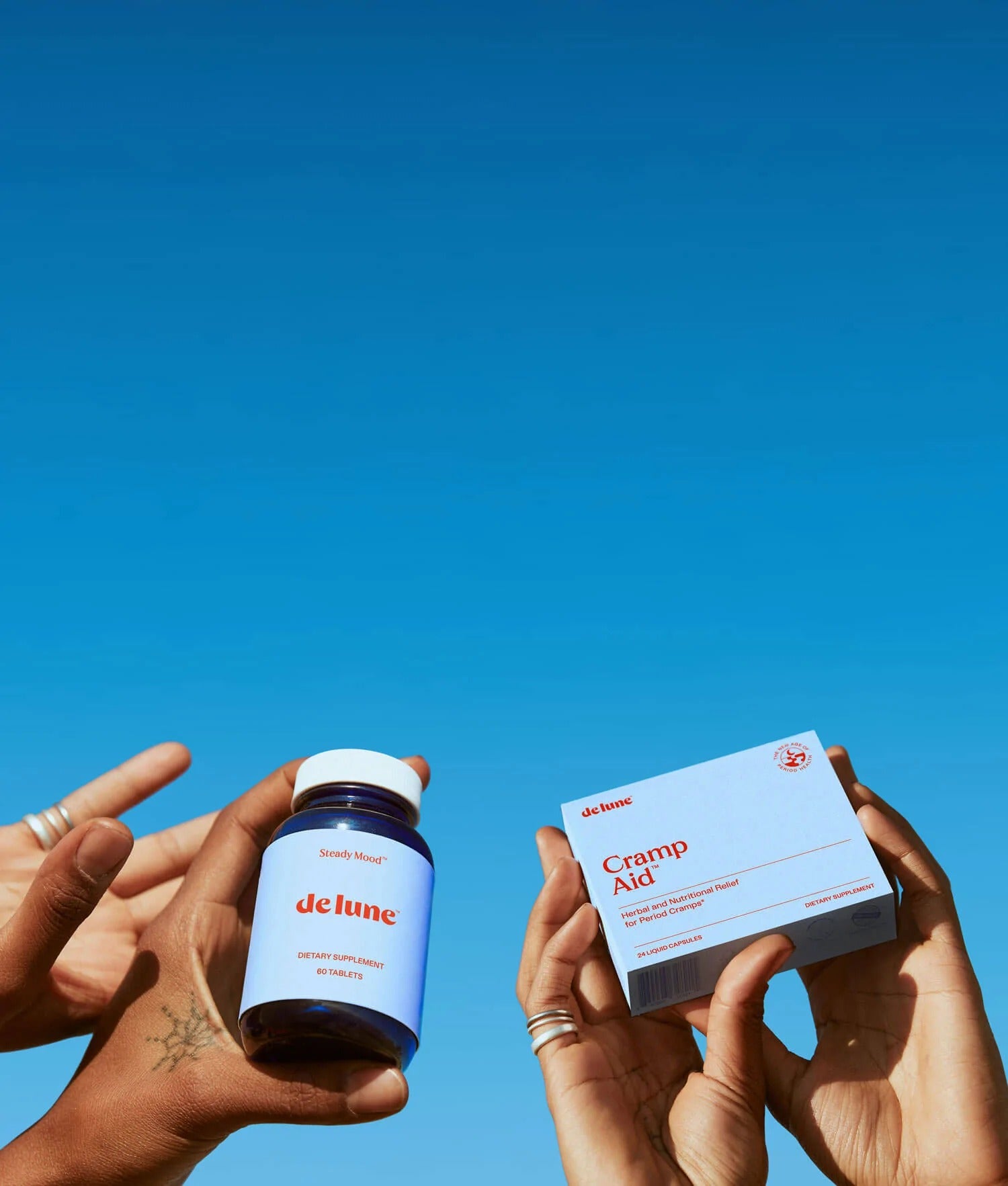Dysmenorrhea—the medical term for period pain—is the most common gynecological disorder in people who menstruate. It’s estimated that between 45% and 95% of people with periods experience dysmenorrhea1. Dysmenorrhea hinders the quality of life and productivity of 60% to 90% of women2.
Most people in Western countries rely on Non-Steroidal Anti-Inflammatory Drugs (also know as NSAIDs, such as aspirin, ibuprofen, and Advil) to manage their period pain. However, these drugs have only been around for the last 100 or so years.
Herbal medicines have been common for thousands of years, long before pharmaceutical companies began making synthetic drugs. Because natural products are known to be effective, many modern pharmaceuticals have an herbal basis. Approximately 60% of the world’s population is dependent almost entirely on plants as medication for all health problems3, including menstrual disorders4.
Anti-inflammatory herbs like fenugreek can be used for same the effect as NSAIDs. Fenugreek, known botanically as Trigonella foenum-graecum, is an important plant with a variety of menstrual difficulties.
Fenugreek Background & Basics
Fenugreek is one of the oldest known medicinal herbs in recorded history, with use dating back to ancient Egypt and ancient Greece5. It’s cited in classical Unani texts—an ancient system of medicine based on the teachings of Hippocrates6—as being useful for relieving pain caused by uterine diseases5.
Fenugreek grows in many parts of the world, including southern Europe, western Asia, India, northern Africa, and the United States7.
In India, fenugreek’s leaves are widely consumed as a leafy green vegetable, while the seeds are a popular condiment used to prepare seasonings, pickles, and curry powders. In Egypt, fenugreek seeds supplement flour for bread making. In Yemen, they’re one of the main constituents of the normal daily diet of the general population3.
Fenugreek seeds are an excellent source of iron, a good source of magnesium, copper, and dietary fiber8.

Fenugreek Can Help Reduce Inflammation & Pain
Fenugreek and NSAIDS have a lot in common. Both have demonstrated anti-fever, antinociceptive (i.e. pain-reducing), and anti-inflammatory properties5,9,10.
NSAIDs reduce inflammation by inhibiting the formation of enzymes that would go on to help make prostaglandins—tiny compounds that act as messenger molecules in the process of inflammation. Fenugreek also reduces inflammation9, but it does so with powerful plant compounds—specifically, alkaloids, flavonoids, saponins, tannins, plant sterols, cumarins, terpenoids, curcumins, and lignins5,11,12. These plant compounds may also help relieve pain.
When fenugreek’s medicinal alkaloid compounds, for example, are extracted as a concentrate, one study reported their effects are similar to morphine13.
NSAIDs are effective at treating dysmenorrhea in about 80% of people with periods14. However, they come with potential side effects. These include stomach pain, constipation, diarrhea, gas, heartburn, nausea, vomiting, and dizziness, though more serious side effects are possible15.
NSAIDs also interfere with mechanisms in the stomach, like mucus production and bicarbonate secretion, that help us digest food and protect against ulcers16. One study concluded that frequent NSAID users are approximately three times more likely to experience serious adverse gastrointestinal events than non-users17.
Because herbs generally do not carry the same risks of side effects as synthetic drugs, many people prefer them to NSAIDS to manage period pain. The use of fenugreek to treat dysmenorrhea is reported from menstruating people all over the world. In modern Egypt and India, fenugreek is still one of the most common herbs used to treat menstrual disorders18,19,20.

Fenugreek Can Also Fight PMS
In addition to reducing inflammation and pain, fenugreek has also demonstrated antioxidant, antispasmodic, diuretic, antihistaminic, anti-diabetic, and immunomodulatory properties4,5,9,11,21,22. Scientists believe that these unique medicinal properties may give it PMS-fighting abilities beyond just reducing period pain.
Fenugreek's diuretic effects may help relieve period bloating by removing excess water weight from the body.
May help control period cravings
Research suggests fenugreek can help control PMS food cravings by suppressing appetite and increasing feelings of fullness.24
Prevents GI issues
Fenugreek's antispasmodic effect may relieve gastrointestinal symptoms before and during your period, like stomach pain and period poops.23
Recent Science Supports Using Fenugreek for Dysmenorrhea
While the science on fenugreek and dysmenorrhea is limited, the data that is available is promising. The first study to clinically investigate the use of fenugreek in the treatment of dysmenorrhea was conducted as recently as 2013. This study was the first of its kind; it investigated the direct link between fenugreek and dysmenorrhea (rather than fenugreek and inflammation, for example), and it did so in real menstruating humans (rather than lab rats).
In this double-blind clinical trial, 101 women with dysmenorrhea were split into two groups. One group received fenugreek supplements for the first 3 days of their cycle. The other group received a placebo.
After two cycles, both groups were asked to rate their pain. The 51 women who received fenugreek experienced statistically significant decreases in the severity of pain, the duration of pain, and reliance on conventional painkillers. In fact, the fenugreek groups’ pain scores decreased from 6.4 at baseline to 3.25 at the end of their second cycle, whereas the placebo groups’ pain scores decreased from 6.14 to only 5.96.25
The women who received fenugreek also experienced statistically significant reductions in systemic symptoms of dysmenorrhea, such as fatigue, nausea, low energy, headache, and mood swings. None of the women who took fenugreek reported any side effects.25
Another research group conducted a similar randomized clinical study in 2016, this time involving 60 women with dysmenorrhea. 20 of these women were given fenugreek for the first three days of their cycle.
The women who received fenugreek experienced a 67% reduction in lower abdominal pain. Authors concluded that fenugreek seed is “efficacious, safe, cost-effective, and well-tolerated.”5

Use Fenugreek Alongside Other Pain-Relieving Strategies
While this emerging evidence suggests fenugreek may be a viable alternative to NSAIDs for managing period pain, conditions such as dysmenorrhea are often best treated through multiple modes of action. Relying on just one method of treatment, such as fenugreek, may not be enough to reduce period pain in some women.
We combed the science for the most effective nutrients and herbs for period pain, and combined them all, including fenugreek, in Cramp Aid—our non-drug solution to period cramps. Learn more here.
References:
1. Proctor, M., & Farquhar, C. (2006). Diagnosis and management of dysmenorrhoea. BMJ: British Medical Journal, 332(7550), 1134.
https://www.ncbi.nlm.nih.gov/pmc/articles/PMC1459624/
2. Li, N., Liu, H., Chen, C., Yang, F., Li, Z., Fang, Z., ... & Chen, D. (2007). CYP1A1 gene polymorphisms in modifying the association between passive smoking and primary dysmenorrhea. Annals of epidemiology, 17(11), 882-888.
3. Al-dalain, S., El-kutry, M. S., & Ibrahim, H. S. (2008). Inhibitory effect of aqueous extracts of barley and fenugreek on ulcer induction in rats. World Appl Sci J, 5(3), 332-9.
https://pdfs.semanticscholar.org/83c3/b8e496b490809a482e424b4aa9634e97fd27.pdf
4. Yassin, S. A. (2012). Herbal remedy used by rural adolescent girls with menstrual disorders. J Am Sci, 8(1), 467-73.
http://www.jofamericanscience.org/journals/am-sci/am0801/065_7998am0801_467_473.pdf
5. Inanmdar, W., Sultana, A., Mubeen, U., & Rahman, K. (2016). Clinical efficacy of Trigonella foenum graecum (Fenugreek) and dry cupping therapy on intensity of pain in patients with primary dysmenorrhea. Chinese journal of integrative medicine, 1-8.
https://link.springer.com/article/10.1007/s11655-016-2259-x
6. Unani Medicine in India: Its Origin and Fundamental Concepts by Hakin Syed Zillur Rahman, History of Science, Philosophy and Culture in Indian Civilization, Vol. IV Part 2 (Medicine and Life Science in India), Ed. B. V. Subbarayappa, Centre for Studies in Civilizations, Project of History of Indian Science, Philosophy and Culture, New Delhi, 2001, pp. 298-325
7. http://www.uofmhealth.org/health-library/hn-2090006
9. Liu, Y., Kakani, R., & Nair, M. G. (2012). Compounds in functional food fenugreek spice exhibit anti-inflammatory and antioxidant activities. Food Chemistry, 131(4), 1187-1192.
http://www.sciencedirect.com/science/article/pii/S0308814611013793
10. Parvizpour, A., Ahmadiani, A., Javan, M., & Kamalinejad, M. (1999). A study on the site of antinociceptive effect of Trigonella foenum graecum (TFG) leaves extract in phasic and tonic models of pain. Physiology and Pharmacology, 3(2), 193-199.
http://phypha.ir/ppj/browse.php?a_code=A-10-71-6&slc_lang=en&sid=1
11. Subhashini, N., Thangathirupathi, A., & Lavanya, N. (2011). Antioxidant activity of Trigonella foenum graecum using various in vitro and ex vivo models. Int J pharm pharm Sci, 3(2), 96-102.
http://ijppsjournal.com/Vol3Issue2/1195.pdf
12. Bahmani, M., Shirzad, H., Mirhosseini, M., Mesripour, A., & Rafieian-Kopaei, M. (2016). A review on ethnobotanical and therapeutic uses of fenugreek (Trigonella foenum-graceum L). Journal of evidence-based complementary & alternative medicine, 21(1), 53-62.
http://journals.sagepub.com/doi/abs/10.1177/2156587215583405
13. Mandegary, A., Pournamdari, M., Sharififar, F., Pournourmohammadi, S., Fardiar, R., & Shooli, S. (2012). Alkaloid and flavonoid rich fractions of fenugreek seeds (Trigonella foenum-graecum L.) with antinociceptive and anti-inflammatory effects. Food and chemical toxicology, 50(7), 2503-2507.
http://www.sciencedirect.com/science/article/pii/S0278691512003043
14. Dawood, M. Y. (2006). Primary dysmenorrhea: advances in pathogenesis and management. Obstetrics & Gynecology, 108(2), 428-441.
https://journals.lww.com/greenjournal/Abstract/2006/08000/Primary_Dysmenorrhea__Advances_in_Pathogenesis_and.29.aspx
15. https://www.fda.gov/downloads/Drugs/DrugSafety/ucm089162.pdf
16. Langman, M.J.S., P. Brok, C.J. Hawkey, F. Silverstein and N. Yeomans, 1991. Non- steroidal anti-inflammatory drug associated ulcer; epidemiology,causation and treatment. J. Gastroenterology and Hepatology, 6: 442-448.
17. Gabriel, S. E., Jaakkimainen, L., & Bombardier, C. (1991). Risk for serious gastrointestinal complications related to use of nonsteroidal anti-inflammatory drugs: a meta-analysis. Annals of internal medicine, 115(10), 787-796.
http://annals.org/aim/article-abstract/705145/risk-serious-gastrointestinal-complications-related-use-nonsteroidal-anti-inflammatory-drugs
18. Assiut University Center for Environmental studies. A study on premenstrual syndrome among Assiut University student. Assiut University Bulletin for Environmental Researches, 2002; 5:2.
19. El-Gilany A, Badawi K and. El-Fedawy S. Epidemiology of dysmenorrhoea among adolescent students in Mansoura, Egypt. Eastern Mediterranean Health Journal, 2005; 11: 1-2.
20. Chauhan, G. D., & Kodnani, A. H. (2016). A study of prevalence and impact of dysmenorrhea and its associated symptoms among adolescent girls residing in slum areas of Vadodara city, Gujarat. Int J Med Sci Public Health, 5(3), 510-5.
https://www.ejmanager.com/mnstemps/67/67-1445510902.pdf
21. Bin-Hafeez, B., Haque, R., Parvez, S., Pandey, S., Sayeed, I., & Raisuddin, S. (2003). Immunomodulatory effects of fenugreek (Trigonella foenum graecum L.) extract in mice. International immunopharmacology, 3(2), 257-265.
http://www.sciencedirect.com/science/article/pii/S1567576902002928?via%3Dihub
22. Baliga, M. S., Palatty, P. L., Adnan, M., Naik, T. S., & Kamble, P. S. (2017). Anti-Diabetic Effects of Leaves of Trigonella foenum-graecum L.(Fenugreek): Leads from Preclinical Studies. J Food Chem Nanotechnol, 3(2), 67-71.
http://unitedscientificgroup.com/journals/ets/articles/v1n1/jfcn-039-manjeshwar-shrinath-baliga.pdf
23. Natarajan B, Dhananjayan R. Pharmacological effects of Trigonella foenum graecum Linn. Seeds on various isolated perfused smooth muscle preparations. Pharmacognosy Magazine, 2007; 3(10):77-82.
24. Bae, J., Kim, J., Choue, R., & Lim, H. (2015). Fennel (foeniculum vulgare) and (fenugreek (trigonella foenum-graecum) tea drinking suppresses subjective short-term appetite in overweight women. Clinical nutrition research, 4(3), 168.
https://www.ncbi.nlm.nih.gov/pmc/articles/PMC4525133/
25. Younesy, S., Amiraliakbari, S., Esmaeili, S., Alavimajd, H., & Nouraei, S. (2014). Effects of fenugreek seed on the severity and systemic symptoms of dysmenorrhea. Journal of reproduction & infertility, 15(1), 41.
https://www.ncbi.nlm.nih.gov/pmc/articles/PMC3955423
This information is for educational purposes only and is neither intended to nor implied to be a substitute for professional medical advice. These statements have not been evaluated by the Food and Drug Administration. This product is not intended to diagnose, treat, cure, or prevent any disease.







